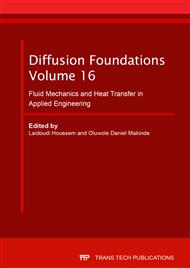[1]
M. Qasim: Heat and mass transfer in a Jeffrey fluid over a stretching sheet with heat source/sink Alexandria Engineering Journal (52)571–575(2013).
DOI: 10.1016/j.aej.2013.08.004
Google Scholar
[2]
B.C. Sakiadis, Boundary layer behavior on continuous solid surfaces: I boundary layer equations for two dimensional and axisymmetric flow, AIChE J. (7) 26–28(1961).
DOI: 10.1002/aic.690070108
Google Scholar
[3]
L.J. Crane, Flow past a stretching plate, Z. Angew. Math. Mech. (21) 645–647(1970).
Google Scholar
[4]
O.D. Makinde, Second law analysis for variable viscosity hydromagnetic boundary layer flow with thermal radiation and Newtonian heating, Entropy (13)1446–1464(2011).
DOI: 10.3390/e13081446
Google Scholar
[5]
Kalidas Das, Nilangshu Acharya, Prabir Kumar Kundu: Radiative flow of MHD Jeffrey fluid past a stretching sheet with surface slip and melting heat Transfer Alexandria Engineering Journal, (54)815–821(2015).
DOI: 10.1016/j.aej.2015.06.008
Google Scholar
[6]
P. K. Pattnaik and T. Biswal: MHD free convective boundary layer flow of a viscous fluid at a vertical surface through porous media with non-uniform heat source, IJISET, 2(3)211-223 (2015).
Google Scholar
[7]
P. K. Pattnaik and T.Biswal: Analytical Solution of MHD Free Convective Flow through Porous Media with Time Dependent Temperature and Concentration, Walailak J Sci & Tech 2015; 12(9): 749-762.
Google Scholar
[8]
B. Mohanty, S. R. Mishra, H. B. Pattnaik, Numerical investigation on heat and mass transfer effect of micropolar fluid over a stretching sheet, Alexandria Engineering Journal,54(2) 223-232(2015).
DOI: 10.1016/j.aej.2015.03.010
Google Scholar
[9]
M. Turkyilmazoglu, : Exact analytical solutions for heat and mass transfer of MHD slip flow in nanofluids. Chem. Eng. Sci. (84)182–187 (2012).
DOI: 10.1016/j.ces.2012.08.029
Google Scholar
[10]
S. Mukhopadhyay, Slip effects on MHD boundary layer flow over an exponentially stretching sheet with suction/blowing and thermal radiation. Ain Shams Eng. J. (4)485–491(2013).
DOI: 10.1016/j.asej.2012.10.007
Google Scholar
[11]
Rashidi, M.M., Ali, M., Freidoonimehr, N., Hossenin, A., Anwar, B.O., Hung, T.K., Homotopy simulation of nanofluid dynamics from a non-linearly stretching isothermal permeable sheet with transpiration. Meccanica, (49)469–482(2014).
DOI: 10.1007/s11012-013-9805-9
Google Scholar
[12]
R.S. Tripathy, S.R. Mishra, G.C. Dash, M.M. Hoque, Numerical analysis of hydromagnetic micropolar fluid along a stretching sheet with non-uniform heat source and chemical reaction, Engineering Science and Technology, An International Journal, (19)1573-1581(2016).
DOI: 10.1016/j.jestch.2016.05.012
Google Scholar
[13]
S R Mishra, P K Pattnaik, M M Bhatti and T Abbas: Analysis of heat and mass transfer with MHD and chemical reaction effects on viscoelastic fluid over a stretching sheet, Indian J Phys DOI 10.1007/s12648-017-1022-2.
DOI: 10.1007/s12648-017-1022-2
Google Scholar
[14]
G.C. Dash, R.S. Tripathy, M.M. Rashidi, S.R. Mishra, Numerical approach to boundary layer stagnation-point flow past a stretching/shrinking sheet, Journal of Molecular Liquids, (221) 860-866(2016).
DOI: 10.1016/j.molliq.2016.06.072
Google Scholar
[15]
K. Avinash, N. Sandeep, O.D. Makinde: Non-uniform heat source/sink effect on liquid film flow of Jeffrey nanofluid over a stretching sheet. Diffusion Foundation, (11)72-83 (2017).
DOI: 10.4028/www.scientific.net/df.11.72
Google Scholar
[16]
R. P. Sharma, K. Avinash, N. Sandeep, O.D. Makinde: Thermal radiation effect on non-Newtonian fluid flow over a stretched sheet of non-uniform thickness. Defect and Diffusion Forum, 377(242-259) (2017).
DOI: 10.4028/www.scientific.net/ddf.377.242
Google Scholar
[17]
O.D. Makinde, S.R. Mishra: Chemically reacting MHD mixed convection variable viscosity Blasius flow embedded in a porous medium. Defect and Diffusion Forum, (374) 83-91(2017).
DOI: 10.4028/www.scientific.net/ddf.374.83
Google Scholar
[18]
W.A. Khan, J.R. Culham, O. D. Makinde: Combined heat and mass transfer of third‐grade nanofluids over a convectively‐heated stretching permeable surface. The Canadian Journal of Chemical Engineering, 93(10)1880-1888 (2015).
DOI: 10.1002/cjce.22283
Google Scholar
[19]
W.A. Khan, R. Culham, O. D. Makinde: Hydromagnetic Blasius flow of power‐law nanofluids over a convectively heated vertical plate. The Canadian Journal of Chemical Engineering, 93 (10)1830-1837 (2015).
DOI: 10.1002/cjce.22280
Google Scholar
[20]
Nemat Dalir: Numerical study of entropy generation for forced convection flow and heat transfer of a Jeffrey fluid over a stretching sheet, Alexandria Engineering Journal, (53)769–778(2014).
DOI: 10.1016/j.aej.2014.08.005
Google Scholar


